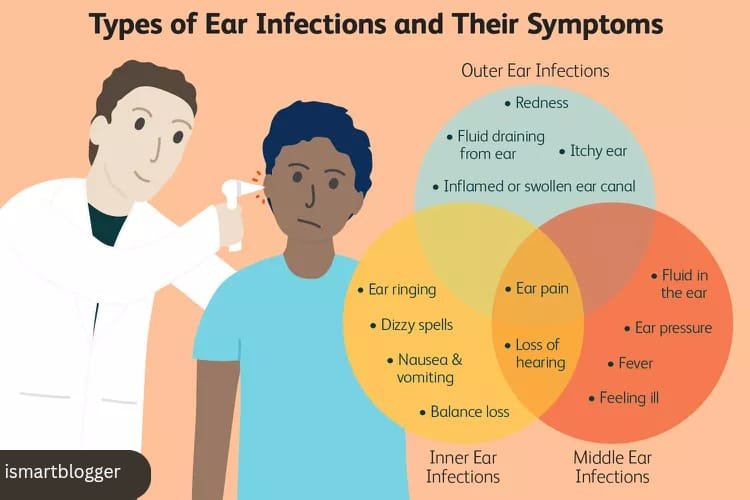Introduction
Ear infections are a common health issue that can affect individuals of all ages, from infants to adults. An ear infection, also known as otitis media or otitis externa, occurs when the middle or outer ear becomes infected and inflamed. This condition can be extremely uncomfortable and may cause severe pain, temporary hearing loss, and other unpleasant symptoms.

Definition of Ear Infection
An ear infection is an inflammation of the middle or outer ear that occurs due to viral or bacterial infections. Otitis media specifically refers to an infection in the middle ear, while otitis externa pertains to an infection in the outer ear canal.
These infections commonly occur when bacteria or viruses enter the ears through the Eustachian tubes. The Eustachian tubes are small passages that connect the middle ear to the back of the throat.
They play a crucial role in regulating air pressure within the ears and draining fluids. When these tubes become blocked or fail to function properly, fluid can accumulate in the middle ear, creating an ideal environment for bacteria or viruses to multiply and cause infection.
Prevalence and Common Causes
Ear infections are prevalent worldwide, with millions of cases reported each year across different age groups. Infants and young children are particularly susceptible due to their immature immune systems and shorter Eustachian tubes compared to adults. However, people of all ages can develop ear infections under certain circumstances.
The most common causes of ear infections include respiratory tract infections such as colds or flu, which can lead to inflammation in the upper respiratory system and subsequently spread into the ears. Other contributing factors include allergies, sinus infections, water exposure (such as swimming), tobacco smoke exposure (passive smoking), changes in altitude during air travel, genetic predisposition, and a weakened immune system.
Importance of Seeking Natural Remedies
When faced with an ear infection, it is vital to address the condition promptly and effectively. While conventional medical treatments like antibiotics or pain-relieving medications can be effective in many cases, there is an increasing interest in natural remedies for several reasons. Natural remedies offer a gentler approach that seeks to support the body’s own healing processes, often without the side effects commonly associated with pharmaceutical interventions.
Additionally, some individuals may prefer natural remedies due to concerns about antibiotic resistance or the desire to limit exposure to chemicals. It is important to note that while natural remedies can provide relief from symptoms and support healing, severe or chronic ear infections may require medical intervention.
Seeking professional advice is crucial, particularly if symptoms worsen or persist despite using natural remedies. Nonetheless, exploring the potential benefits of natural approaches can be a valuable addition to one’s overall health management.
Understanding Ear Infections
Types of Ear Infections (Otitis Externa, Otitis Media, etc.)
Ear infections can occur in different parts of the ear, leading to various types of infections. One common type is otitis externa, also known as swimmer’s ear. This infection affects the outer ear and ear canal, usually caused by bacterial or fungal growth due to excessive moisture or damage to the skin lining the ear canal.
Another type is otitis media, which affects the middle ear and is often associated with a respiratory infection. Otitis media can occur when bacteria or viruses enter the middle ear through the Eustachian tube.
Additionally, there are less common types such as chronic suppurative otitis media, where an infection persists for more than three months with recurring discharge from the middle ear. Acute mastoiditis is another rare but severe form of ear infection that occurs when untreated otitis media spreads to the mastoid bone behind the ear.
Symptoms and Complications
The symptoms experienced during an ear infection may vary depending on factors like age and severity. Common signs include pain or discomfort in one or both ears, accompanied by a feeling of fullness or pressure. Young children may display irritability, pulling at their ears, difficulty sleeping, or experiencing changes in appetite.
Complications can arise if an infection goes untreated or becomes chronic. These may include temporary hearing loss due to fluid buildup in the middle ear (otitis media with effusion), ruptured eardrums leading to discharge from the affected area (otorrhea), balance problems and dizziness (labyrinthitis), and even facial muscle paralysis (Ramsay Hunt syndrome).
Diagnosis and Treatment Options
To diagnose an ear infection accurately, a healthcare professional will examine your ears using an otoscope to inspect the ear canal and eardrum. They may also evaluate your symptoms, medical history, and perform a hearing test if necessary. In some cases, a sample of fluid from the middle ear might be collected for analysis.
Treatment options for ear infections typically depend on the type and severity of the infection. For bacterial infections, antibiotics are commonly prescribed to eliminate the bacteria causing the infection.
However, it’s important to note that overprescribing antibiotics can contribute to antibiotic resistance. Pain relief medications like nonsteroidal anti-inflammatory drugs (NSAIDs) or topical numbing agents may be recommended to alleviate discomfort.
In cases where fluid persists in the middle ear or recurrent infections occur, surgical intervention such as placing tympanostomy tubes may be considered. Overall, understanding the different types of ear infections, recognizing their symptoms and potential complications, as well as being aware of available diagnosis and treatment options is crucial in effectively managing this common ailment.
Natural Remedies for Ear Infections: An Overview
Advantages of natural remedies over conventional treatments
Natural remedies for ear infections have gained popularity due to their numerous advantages over conventional medical treatments. One significant advantage is the reduced risk of side effects. Unlike many medications, natural remedies are typically derived from plant-based sources and have a milder impact on the body, minimizing the chances of adverse reactions or allergies.
Moreover, natural remedies often address the root cause of the infection rather than just alleviating symptoms, promoting long-term healing. Another advantage of natural remedies is their holistic approach to healing.
Conventional treatments often focus solely on treating the infection itself, leaving out other aspects that contribute to overall well-being. Natural remedies, on the other hand, take into account factors like boosting immunity and reducing inflammation throughout the body.
This comprehensive approach supports not only ear health but also general systemic balance. Furthermore, natural remedies offer a more sustainable and cost-effective alternative to conventional treatments.
Many ingredients used in these remedies can be found in everyday kitchens or gardens, making them easily accessible and affordable without compromising effectiveness. By utilizing readily available resources instead of relying solely on pharmaceutical interventions, individuals can take charge of their health in a more self-sufficient manner.
General tips for managing ear infections naturally
While specific remedies will be discussed later in this article, there are some general tips that can help manage ear infections naturally. First and foremost, maintaining proper hygiene plays a vital role in preventing and managing ear infections.
Keeping ears clean by gently wiping with warm water or using saline solutions can help remove excess wax and debris that may harbor bacteria or fungi. Additionally, avoiding exposure to irritants such as smoke or chemical pollutants can reduce the risk of developing an ear infection or worsening an existing one.
It’s important to remember that smoke irritates delicate tissues within the ears and compromises their natural defense mechanisms. By creating a smoke-free environment and minimizing exposure to harmful substances, individuals can support the healing process.
Proper rest and stress management are also crucial in managing ear infections naturally. Ensuring an adequate amount of sleep and reducing stress levels allows the body to focus on healing and strengthens the immune system’s response to infection.
Adequate hydration and a balanced diet rich in nutrients, particularly vitamins A, C, D, and E, help support overall health and specifically aid in preventing recurrent ear infections. Moreover, practicing good respiratory hygiene by covering the nose or mouth while coughing or sneezing can mitigate the risk of respiratory infections that often lead to ear infections.
It is essential to remember that prevention is key in managing ear infections naturally, as it reduces reliance on treatments later on. By implementing these general tips along with specific natural remedies discussed later in this article, individuals can take an active role in managing their ear health naturally while promoting overall well-being.
Herbal Remedies for Ear Infections
Garlic oil: its antimicrobial and anti-inflammatory properties
Underneath the surface of its humble appearance, garlic holds an impressive array of medicinal benefits. Known for centuries as a potent natural remedy, garlic’s antimicrobial and anti-inflammatory properties make it an excellent choice for treating ear infections.
Garlic contains a compound called allicin, which exhibits powerful antimicrobial activity against a wide range of pathogens, including bacteria and fungi that commonly cause ear infections. Additionally, garlic possesses anti-inflammatory properties that help reduce swelling and relieve pain in the affected area.
How to prepare garlic oil at home
Preparing garlic oil at home is a simple and cost-effective process that allows you to harness the healing potential of this remarkable herb. Start by finely mincing three to four cloves of fresh garlic.
Then, gently heat two tablespoons of olive oil in a small saucepan over low heat. Add the minced garlic to the warm oil and allow it to infuse for 20-30 minutes while stirring occasionally.
Once infused, strain the mixture using cheesecloth or a fine-mesh sieve to remove any solid particles. The resulting golden-hued oil is now ready for use as a natural remedy for ear infections.
Proper application techniques and precautions
When using garlic oil to treat an ear infection, it is crucial to exercise caution and follow proper application techniques to ensure safety and effectiveness. Begin by warming the prepared garlic oil slightly by placing the bottle in warm water or holding it between your hands for a few minutes.
It’s essential not to heat the oil too much; lukewarm temperature is ideal. Using a dropper or clean cotton ball, carefully administer two to three drops into the affected ear while tilting your head sideways.
Gently massage around the outside of your ear canal in a circular motion to aid absorption. Repeat this process two to three times a day, but discontinue use if any discomfort or irritation occurs.
Mullein oil: soothing effects on the ear canal
Another herbal remedy that offers soothing effects for ear infections is mullein oil. Derived from the yellow flowers of the mullein plant, this oil has been used for centuries due to its anti-inflammatory properties and ability to soothe irritated tissues. When applied topically, mullein oil forms a protective barrier and aids in reducing inflammation and pain within the ear canal.
Benefits of mullein oil in reducing inflammation and pain
Mullein oil’s therapeutic benefits lie in its rich content of mucilage compounds, which impart emollient properties. These compounds help soften and lubricate dry or inflamed tissues surrounding the ear canal, providing relief from pain and discomfort associated with infection or inflammation. Additionally, mullein contains saponins that possess expectorant properties, aiding in the expulsion of excess mucus trapped within the Eustachian tubes.
Safe ways to use mullein oil for ear infections
To safely utilize mullein oil for alleviating ear infections, start by warming a small amount of the oil by placing it in a container of warm water. Using a sterile dropper or clean cotton ball, administer two to three drops into the affected ear while tilting your head sideways. Gently massage around the outer portion of your ear to ensure even distribution of the oil within the canal.
Repeat this process three times daily until symptoms subside. Remember always to consult with a healthcare professional before using any herbal remedy, especially if you have pre-existing medical conditions or are currently taking medications.
Chamomile tea compresses: calming inflamed tissues
Known for its soothing properties, chamomile tea has long been used to calm various ailments, including ear infections. The anti-inflammatory and analgesic effects of chamomile make it an effective natural remedy for relieving pain and discomfort associated with ear infections.
Benefits of chamomile tea in relieving pain and discomfort
Chamomile contains various bioactive compounds, such as chamazulene and apigenin, which possess strong anti-inflammatory properties. These compounds help reduce inflammation in the ear canal, providing relief from pain. Furthermore, chamomile has a gentle sedative effect that can aid in relaxation and potentially alleviate any stress or anxiety caused by the painful symptoms of an ear infection.
Preparation methods for chamomile tea compresses
To prepare a soothing chamomile tea compress, start by steeping two teaspoons of dried chamomile flowers in a cup of boiling water for about 10 minutes. Once infused, strain the liquid and allow it to cool until it reaches a comfortable temperature.
Soak a clean cloth or cotton pad in the cooled tea and gently wring out any excess liquid. Place the warm compress against the affected ear for 10-15 minutes, allowing the calming properties of chamomile to work their magic on inflamed tissues.
Repeat this process several times throughout the day for optimal relief. Incorporating these herbal remedies into your approach can provide natural relief from the symptoms associated with ear infections.
However, it is essential to consult with a healthcare professional if symptoms persist or worsen over time. Remember that while natural remedies can be beneficial additions to overall health management, they should not replace proper medical care when necessary.
Homeopathic Remedies for Ear Infections
Mercurius solubilis: Relieving Symptoms Associated with Otitis Media
Ear infections, particularly otitis media, can cause severe discomfort and pain. Mercurius solubilis, a commonly used homeopathic remedy, has shown efficacy in alleviating the symptoms associated with this type of ear infection.
Mercurius solubilis is derived from mercury and is often prescribed when an infection affects the middle ear. It is believed to stimulate the body’s immune response and promote healing.
How Mercurius solubilis Works on the Body’s Immune Response
Mercurius solubilis works by enhancing the body’s natural ability to fight off infections. It stimulates the immune system, helping it recognize and respond to pathogens that may be causing the ear infection.
By boosting immune activity, Mercurius solubilis aids in reducing inflammation in the middle ear and promoting faster recovery. It is important to note that homeopathic remedies like Mercurius solubilis are highly diluted substances and work on a principle known as “like cures like.” This means that small amounts of a substance capable of producing symptoms similar to those experienced during an illness or infection are used to treat those symptoms.
Proper Dosage Guidelines and Potential Side Effects
When using homeopathic remedies such as Mercurius solubilis for ear infections, it is crucial to follow proper dosage guidelines recommended by a qualified homeopath or healthcare professional. The appropriate dosage may vary depending on individual factors such as age, severity of symptoms, and overall health.
In general, it is advisable to take lower potencies (e.g., 6C or 30C) of Mercurius solubilis every few hours until improvement occurs. However, it is crucial to consult with a knowledgeable professional before starting any homeopathic treatment.
They can guide you on the best dosage and monitor your progress. While homeopathic remedies are generally considered safe, it’s essential to be aware of potential side effects that may occur in rare cases.
These can include mild gastrointestinal symptoms or allergic reactions. If any adverse effects occur, it is important to discontinue use and consult with a healthcare provider.
Pulsatilla: Addressing Ear Infections Caused by Allergies or Colds
Ear infections that arise from allergies or colds can be effectively managed using Pulsatilla, a versatile homeopathic remedy. Pulsatilla is derived from the windflower plant and has been traditionally used for various respiratory conditions, including ear infections triggered by seasonal allergies or viral infections.
The Unique Properties of Pulsatilla in Treating Specific Symptoms
Pulsatilla exhibits unique characteristics that make it suitable for addressing ear infections caused by specific symptoms. It tends to be more beneficial when there is thick discharge from the ears, accompanied by pain that worsens at night. Individuals who require Pulsatilla often experience relief when exposed to fresh air and find comfort in cool rooms.
This homeopathic remedy aims to alleviate congestion in the ear passages, reduce inflammation, and promote drainage of excessive fluid buildup. The specific symptoms experienced by each individual will determine whether Pulsatilla is the most appropriate choice for their condition.
Administration Methods and Considerations
Pulsatilla is typically available as small pellets or liquid dilutions. The suitable potency and dosage of Pulsatilla will depend on various factors such as age, severity of symptoms, and individual response. It is advisable to seek guidance from a qualified homeopath or healthcare practitioner for accurate dosage recommendations.
In some cases, self-administration may not be appropriate, particularly for children or individuals with complicated medical histories. Therefore, professional consultation is crucial to ensure safe and effective use of Pulsatilla.
Regular follow-up with a healthcare provider will also help monitor progress and adjust the treatment plan if necessary. Using Pulsatilla as part of a holistic approach that includes adequate rest, hydration, and healthy lifestyle practices can contribute to a faster recovery from ear infections caused by allergies or colds.
However, it is essential to bear in mind that homeopathic remedies should be used as complementary treatments alongside conventional medical care, especially in severe or recurrent cases. Remember that each person’s response to homeopathic remedies may vary, so it is crucial to consult with a qualified practitioner for personalized advice before embarking on any self-treatment regimen.
D. Conclusion
Natural Remedies for Ear Infections: A Holistic Approach
Harnessing the Power of Nature
Natural remedies offer a promising alternative for managing ear infections. Herbal remedies like garlic oil, mullein oil, and chamomile tea compresses boast antimicrobial and soothing properties. Homeopathic options like Mercurius solubilis and Pulsatilla target specific symptoms. These natural solutions not only address the infection but also promote overall well-being.
Empowering Yourself Through Natural Care
Consulting a healthcare professional is crucial for diagnosis and guidance. However, exploring natural options empowers individuals seeking more control over their health. Remember, responses to these remedies may vary, so patience and consistency are key.
Natural Healing and Self-Care
In a world reliant on pharmaceuticals, natural alternatives foster a sense of self-care. By incorporating practices like Ayurveda, you can take charge of your health and well-being.
Prevention: The Best Medicine
Preventing ear infections is vital. Maintain good hygiene by regularly washing hands and keeping ears dry after swimming or showering.
Conclusion: A Path to Wellness
By combining practical measures with the power of natural remedies, we can optimize our chances of enjoying a life free from ear infections. Embrace a holistic approach and relish the power of nature for optimal health





